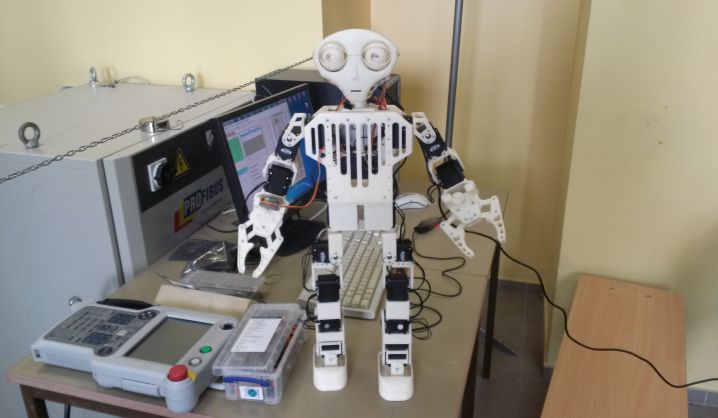- Programmes in English 2025/2026
- Admission 2024/2025 Scholarships
- For exchange students
- Free Movers
- Transfer studies
- Erasmus+ studies and traineeships
- Mentor programme
- Student testimonials
- Accommodation
- Career Services
- Medical Care
- Immigration Regulations
- Leisure and Student Activities
- Useful information
- VILNIUS TECH for Creators of Tomorrow
- Mental and spiritual support
- Representatives Abroad
- Contacts
- Computer Engineering

2015-08-19
New surprise: students have developed a robot humanoid
Lately, a wide audience learned about the greatest invention of Edita Verbickaitė, student of Vilnius Gediminas Technical University (VGTU) – the technology, allowing printing orthopaedic inserts and splints on 3D printer. Now a new surprise of the students of this higher education institution: a team of three students of the Department of Mechatronics and Robotics have created a real robot humanoid, while preparing their undergraduate theses. Like many great ideas, this one broke unexpectedly, partly, because of students‘ habit to postpone everything until the last minute and because of a promise to Indian students.
"In autumn, everyone had to choose a topic and supervisor for the final thesis. As everywhere, the rule ‘‘first come, first served‘‘ was valid here, too. For those who were the last, only the teachers who did not deliver lectures and whom we did not know, were available. Our friend‘s teacher Robertas Urbanavičius suggested not only to create a robot humanoid, existing in the drawings and 3D models, but make a real robot humanoid,‘‘ - said Mindaugas Lučiūnas, one of the authors of the invention, about the prehistory of the robot creation.
A working team of students has been appointed, because we had to finish our Bachelor‘s thesis till spring, and the task of creating a robot humanoid was far more complicated than building a Lego car. Gediminas Liška and Vladislavas Rusinas were among others, and the head of the project was R. Urbanavičius, the Associate Professor of the Department of Mechatronics and Robotics of the Faculty of Mechanics at VGTU, coordinating many projects in applied mechanics, mechatronics and robotics, performed by the students of our faculty. He was often inviting foreign students to study in Lithuania, and once an Indian student said: "If you create a walking robot, there will be no doubts for us, where to study‘‘.
Although this project has not been fully implemented yet (the robot is standing perfectly well, maintains its balance, when pushed, but in the meantime, it does not walk), it is really an exceptional project in Lithuania.
"The result of our work is a 60 cm tall robot humanoid, with 25 degrees of freedom. Like a human being, it has the feet, the arms, and the head. We fitted a gripper as an end effector in the robot arms for grasping objects. His eyes can swivel from side to side, and the eyelids — to follow the eyes and move the eyelids. Our aim was to create a good learning tool and research platform for our future students. It is also a great way to show how VGTU students implement their ideas, together with their theory studies,‘‘ - said M. Lučiūnas, who also explained that similar robots can help children with autism, people after a stroke with serious consequences and people with walking disabilities; they can also compete in various sport events or even water flowers. Currently, the market price of such functioning robots starts from several thousand euros and goes steeply up.
VGTU graduate says that first of all, the newly set up team discussed the robot‘s weight, the materials from which they should produce it and the functions it should be able to perform. After that, they distributed their work: Vladislavas constructed the robot‘s arms, Gediminas - the feet, and Mindaugas - the head, according to the parts of the robot, to be more precise. Later, they analysed similar products, held discussions with teachers, made sketches, calculated the nodes, created the 3D models, produced the details and then the best part of the project followed - the assembly and testing of the robot.
M. Lučiūnas was happy to use the 3D printer at the University, so he had no problems with complex details. The biggest personal challenge for him was to install all necessary functions into a small head of the robot. According the guy who decided to continue his Master‘s studies in Mechatronics next academic year, the team spent all spare time for the improvement of their robot: they tried to force him walk, grasp objects, express emotions. Traditionally, they ran out of one night before the final presentation, for robot programming.
"Currently, our robot is standing, is able to manipulate things by hands, to turn head and eyes. The latest upcoming improvements should be equipping the robot with sensors, installing video cameras into the eyes, and gluing up several microphones, distance and tactile sensors. All these equipment will allow the robot to autonomously recognize the surrounding environment, avoid obstacles, grab and manipulate objects and react to the sounds and emotions of the surrounding people,‘‘ – said VGTU graduate about the possible future developments.
"We hope to continue our work with this humanoid robot. Though there is still a long way to the perfection, we have already made a great job, a good example for the younger students. The popularity of humanoid robots is increasing all over the world, so we could also be among the leaders,’’– adds the professor.
The supervisor of this exceptional project stressed the importance of performing a real, tangible work while a student – there is no wonder, they predict bright career prospects for the robot developers’ team who gained valuable scientific and teamwork experience.











